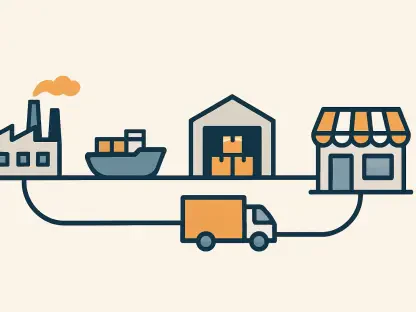In today’s rapidly evolving digital landscape, Chloe Maraina stands as a leading expert in business intelligence and data science. Her dedication to unraveling the intricacies of big data and her forward-thinking vision for data management have made her a sought-after voice in the field. We sat down with Chloe to explore the complexities of data fabric and its critical role in enhancing data security and governance.
What exactly is data fabric, and why is it often difficult for organizations to define?
Data fabric is essentially a technology-driven framework that simplifies the integration and management of data across various environments—whether that’s on-premises, cloud, or hybrid. The challenge in defining it stems from the multitude of vendor-specific interpretations that often lead to confusion. While the basic concept involves creating a unified layer to manage distributed data, nuances in vendor offerings make a one-size-fits-all definition elusive.
How does data fabric architecture function in integrating and managing data across different sources and platforms?
At its core, data fabric acts as the connective tissue for disparate data silos, enabling seamless data integration. It leverages metadata to orchestrate data across platforms, ensuring a holistic view of data assets. This abstraction not only facilitates data unification for business and AI initiatives but also allows organizations to work with existing data management tools without needing a complete overhaul.
What are the key elements of a data fabric architecture?
The three pivotal components of data fabric architecture include metadata-driven data identification, knowledge graphs, and automated machine learning-based data management. These elements work together to offer visibility across data sources, thereby enabling businesses to exploit their data efficiently while supporting intelligence-driven outcomes.
How can metadata-driven data identification and classification enhance data management?
By automating the identification and classification of data through metadata, organizations gain a comprehensive view of their data landscape. This level of insight not only improves data governance but also aids compliance efforts by ensuring sensitive data is properly managed according to regulatory requirements.
What role do knowledge graphs play in a data fabric architecture?
Knowledge graphs provide the framework for connecting and organizing complex relationships between data entities. In a data fabric setup, they enhance context and understanding, facilitating more informed decision-making and enabling AI-driven insights which are crucial for modern data analytics.
How does machine learning (ML) contribute to the automation of data management within a data fabric?
Machine learning brings automation to data management tasks through predictive analytics, anomaly detection, and even suggesting data governance policies. ML algorithms can sift through vast datasets to identify patterns and anomalies that traditional rule-based systems might miss, thus streamlining the management and security processes.
What are the main data security challenges that organizations face when implementing a data fabric architecture?
The fragmentation of data across different environments poses a significant security challenge. Each environment might have unique security protocols, complicating the task of maintaining a unified control system. Additionally, data silos can lead to inconsistencies in data accessibility and security, making comprehensive governance difficult.
How does fragmentation affect data security and governance, especially in organizations operating across multiple cloud environments?
Fragmentation disperses data across multiple environments, each with its own security and governance idiosyncrasies, resulting in a patchwork of security measures. This lack of uniformity can lead to holes in data protection strategies, raising the risk of data breaches and non-compliance with regulations.
What compliance and regulatory complexities do organizations encounter when adopting data fabric?
Navigating the variety of regulatory frameworks across jurisdictions—such as GDPR, HIPAA, and CCPA—becomes more complex as data sources proliferate in a data fabric. A coherent compliance strategy across these frameworks is essential, yet challenging, necessitating careful planning and execution to align disparate data systems under unified regulations.
How does the diverse nature of data types and sources complicate regulatory compliance in a data fabric environment?
Different data types and sources may be subject to different regulatory requirements, creating a matrix of compliance needs. Implementing consistent controls across all these requirements within a data fabric calls for comprehensive data governance strategies that address the unique demands of each data type while ensuring overall compliance.
Why is talent acquisition a critical challenge in the successful implementation of data fabric, and how are organizations addressing this issue?
The intricate nature of data fabric requires specialized skills that are currently scarce in the job market, creating a talent gap. Organizations address this by investing in upskilling their current workforce, partnering with educational institutions to develop tailored programs, and fostering a culture of continuous learning to stay ahead of the evolving data landscape.
Can you explain the role of Shadow IT in complicating data security and governance within data fabric?
Shadow IT—technology systems employed within organizations without explicit organizational approval—can undermine data security by introducing ungoverned data sources into the infrastructure. Identifying and integrating these data sources into the fabric is essential to eliminate blind spots and maintain comprehensive governance.
How does data fragmentation hinder effective security and governance, and what solutions are available to address this issue?
Data fragmentation can create isolated pockets of information that are hard to govern and secure uniformly. Implementing a centralized data governance framework through a well-architected data fabric helps mitigate these issues by standardizing security policies and data management practices across diverse data environments.
In what ways does the complexity of an organization’s IT environment pose challenges to data fabric security and governance?
An intricate IT environment may consist of legacy systems, modern technologies, and multiple cloud platforms, each with different protocols and security measures. Aligning these under a coherent data fabric requires a nuanced understanding of each component and the ability to harmonize their differences towards a unified security and governance strategy.
What advantages does data fabric offer for improving data security and governance?
The primary benefit of a data fabric is its ability to establish centralized security and governance policies that are consistently enforced across all data assets. This uniformity not only simplifies compliance but also reduces the likelihood of data breaches by standardizing security measures and access controls throughout the organization.
How do centralized security policies within a data fabric architecture help organizations overcome fragmentation challenges?
Centralized security policies allow organizations to apply consistent rules and procedures across their entire data ecosystem. By leveraging metadata, these policies can dynamically adapt to control access and operations on various data assets, ensuring compliance and security are maintained irrespective of the underlying data sources.
How does a data fabric architecture assist organizations in maintaining regulatory compliance?
By providing a deeper understanding and control over data flows, a data fabric architecture supports organizations in pinpointing regulatory-sensitive data and implementing necessary safeguards. This proactive management facilitates real-time compliance with evolving regulatory landscapes, reducing the risk of infractions.
What benefits does automated metadata management and data cataloging provide in a data fabric setting?
Automated metadata management and data cataloging enhance visibility and traceability of data throughout its lifecycle. This automation reduces manual effort, aids in regulatory compliance, and provides security insights that are crucial for safeguarding data integrity and confidentiality.
How does automated data discovery and classification enhance governance and reduce manual effort?
By automating data discovery and classification, organizations can quickly identify and categorize sensitive data, apply the necessary protections, and comply with regulatory requirements more efficiently. This reduces the manual workload on IT teams and enhances the organization’s ability to adapt to changes in the data landscape.
Can you explain the importance of granular access control and how data fabric supports it?
Granular access control is critical for ensuring that only authorized individuals have access to sensitive data. A data fabric supports this through sophisticated access control models like Role-Based and Attribute-Based Access Control, which dynamically adjust permissions based on user roles and data attributes, minimizing risks of unauthorized data access.
What are the roles of data encryption and masking within a data fabric, and why are they crucial?
Encryption and masking are essential for protecting data both at rest and during transit by obscuring sensitive information. Encryption secures data by making it unreadable without the correct keys, while masking replaces it with fictitious but realistic values, ensuring personal and corporate data privacy is maintained across the data lifecycle.
How does a data fabric support the implementation of data governance frameworks?
A data fabric provides the toolkit for defining, monitoring, and enforcing data governance policies. It aligns data management processes with organizational objectives, ensuring compliance with regulations and enhancing accountability by making data stewardship an integral part of the data management strategy.
Why is data validation critical in ensuring data security and governance within a data fabric environment?
Data validation is vital for maintaining the trustworthiness of data in BI and AI initiatives. Without it, organizations risk making decisions based on flawed or inconsistent data. Ensuring data is validated as early as possible helps prevent errors from propagating, which is crucial in maintaining reliable and secure data systems.
What strategies are effective in validating data within a data fabric, according to industry experts?
Effective strategies start with implementing validation checks close to data sources to reduce downstream errors. Incorporating machine learning for anomaly detection and employing cross-domain consistency checks also aid validation efforts by catching discrepancies that rule-based systems might overlook.
How is machine learning leveraged to improve data validation and trust in data assets?
Machine learning enhances data validation by establishing statistical baselines and detecting anomalies across data streams. It identifies irregularities that conventional validation methods might miss, thereby increasing the reliability of data assets and boosting trust in their integrity and accuracy.
What are some real-world benefits and use cases of data fabric implementation across various industries?
Data fabric implementations deliver profound business benefits, such as improved data access speed, enhanced security, and regulatory compliance. Industries ranging from finance to healthcare have seen reductions in reporting times, increased data accuracy, and improved efficiency in data integrations, leading to better decision-making and operational performance.
How have large enterprises benefited from data fabric in terms of data access and security at scale?
Large enterprises have realized substantial benefits from data fabric by speeding up data access and enhancing data security at scale. For example, global financial institutions have significantly reduced regulatory reporting times and improved data governance outcomes by aligning operations with unified security protocols.
What is your forecast for data fabric’s role in future data security and governance?
As data environments grow more complex, the role of data fabric will likely expand to address newer dimensions of data security and compliance. Future data fabrics will leverage advancements in AI to provide even more intelligent, adaptive, and holistic data management solutions, becoming an essential tool in the arsenal of any data-oriented organization aiming to harness its data successfully. As digital transformation continues to evolve, mastering data fabric will be crucial for organizations intent on leveraging data as a strategic asset to drive business growth.









